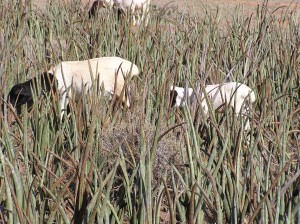 This project is investigating how and why Sansevieria volkensii, a humble succulent native to Kenyan drylands, has become a pernicious pest plant. The proliferation has coincided with intensifying grazing pressure in the area and drastic reduction of grass cover. The plant used to occur sparsely, but now forms large, dense patches that impede people and livestock movement and utilization of the landscape. While viewed by residents as horrible, these patches harbor remnant populations of grasslands and forbs. So the patches may actually be preventing the ecosystem from even more severe collapse.
This project is investigating how and why Sansevieria volkensii, a humble succulent native to Kenyan drylands, has become a pernicious pest plant. The proliferation has coincided with intensifying grazing pressure in the area and drastic reduction of grass cover. The plant used to occur sparsely, but now forms large, dense patches that impede people and livestock movement and utilization of the landscape. While viewed by residents as horrible, these patches harbor remnant populations of grasslands and forbs. So the patches may actually be preventing the ecosystem from even more severe collapse.
We continue to monitor the spread of patches, particularly in areas where Sanse appears to be just starting to expand. With almost 5 years of data, measuring rates of spread and associated environmental variables, we’re about ready to draw some conclusions about the conditions that favor establishment, and those that favor proliferation.
Collaborators: Trenton Franz [School of Natural Resources, University of Nebraska] and Kelly Caylor [Department of Civil & Environmental Eng., Princeton University]